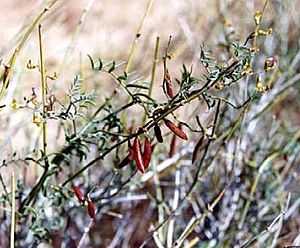Lane Mountain milkvetch facts for kids
Quick facts for kids Lane Mountain milkvetch |
|
|---|---|
 |
|
| Conservation status | |
| Scientific classification | |
| Genus: |
Astragalus
|
| Species: |
jaegerianus
|
Astragalus jaegerianus is a very special and rare plant. Its common name is Lane Mountain milkvetch. It's a type of milkvetch, which is a group of plants in the pea family. This plant was named after a biologist named Edmund Jaeger. He was the first person to write about it in 1939.
About the Lane Mountain Milkvetch
Where It Lives
This plant grows only in a small area. It is found in the northeastern part of San Bernardino County, California. There are only four known groups of these plants. They all live near Fort Irwin National Training Center in the Mojave Desert. Because it is so rare, the U.S. government lists it as an endangered species. This means it is protected by law.
What It Looks Like
The Lane Mountain milkvetch is a plant that comes back every year. It has thin stems covered in tiny hairs. These stems can grow from 30 to 70 centimeters long. They often get tangled with nearby shrubs.
If there isn't much rain, the plant might only grow a few centimeters. But after a lot of rain, it can climb high. It might even reach the tops of other shrubs. Its leaves are 2 to 5 centimeters long. They have several narrow leaflets that are spaced out. The top of these leaflets also has hairs.
Flowers and Fruit
The plant has an open group of up to 15 flowers. These flowers are pale purple with dark lines. Each flower is about one centimeter long. Insects help these flowers make seeds. The most common insect helper is a type of bee called Anthidium dammersi.
After the flowers bloom, the plant grows a fruit. This fruit is a hanging pod called a legume. It can be up to 2.5 centimeters long. The pod has no hairs and dries to feel like leather or thick paper.


